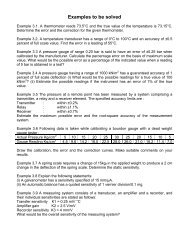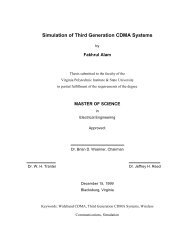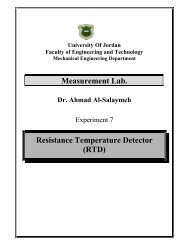Communications I Dr. Mohammed Hawa Introduction to Digital - FET
Communications I Dr. Mohammed Hawa Introduction to Digital - FET
Communications I Dr. Mohammed Hawa Introduction to Digital - FET
Create successful ePaper yourself
Turn your PDF publications into a flip-book with our unique Google optimized e-Paper software.
5. Duobinary:In a duobinary line code a 0 bit is represented by a zero-level electric voltage; a 1 bitis represented by a p(t) if the quantity of 0 bits since the last 1 bit is even, and by -p(t)if the quantity of 0 bits since the last 1 bit is odd. An illustration of the duobinary linecode is shown below.ClockData 1 1 1 0 1 1 0 0 0 1 0 0 1Code0Duobinary CodeFor a bit rate of f0, duobinary line code requires f0/2 bandwidth, which is theminimum possible (theoretical) bandwidth for any digital baseband signal (calledNyquist bandwidth). In addition, the duobinary line code permits the detection ofsome transmission errors without the addition of error-checking bits. However,duobinary line codes have significant low frequency components as seen by the PSDshown earlier. The differential version of the duobinary line code is common in the20 Gbit/s and 40 Gbit/s uncompensated optical fiber transmission systems.It is important, however, that you do not confuse a duobinary line code (explainedabove) with something completely different called a duobinary pulse (shown below).This pulse (which you are going <strong>to</strong> study in the “<strong>Communications</strong> II” course) iscommonly used in controlled inter-symbol interference (ISI) scenarios. Confusingly,duobinary signaling refers <strong>to</strong> using the duobinary pulse with a polar line coding rule(not a duobinary line coding rule).p(t) = Duobinary Pulse1 V-3T 0-2T 0-T 00T 02T 03T 0t6. Multi-Level Transmission 3-Levels (MLT-3):MLT-3 encoding is used mainly in 100BASE-TX Fast Ethernet, which is the mostcommon type of Ethernet nowadays. MLT-3 cycles through the states -p(t), 0, p(t), 0,-p(t), 0, p(t), 0, ... etc. It moves <strong>to</strong> the next state <strong>to</strong> transmit a 1 bit, and stays in thesame state <strong>to</strong> transmit a 0 bit.MLT-3 has many advantages including emitting less electromagnetic interference,requiring less bandwidth than unipolar, polar, and bipolar (AMI) signals operatingat the same data bit rate. The PSD of MLT-3 code is shown in Figure 22.13
















